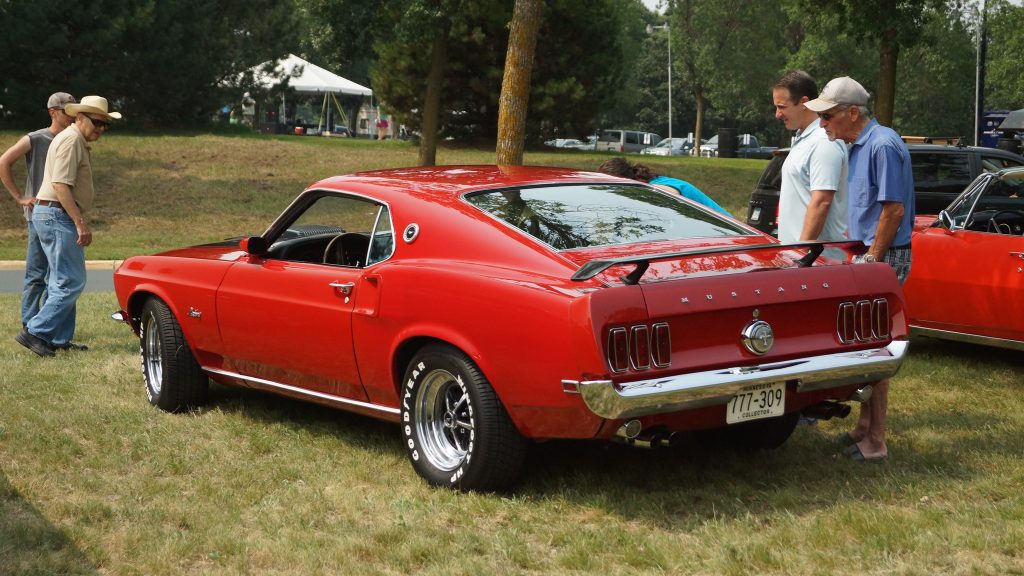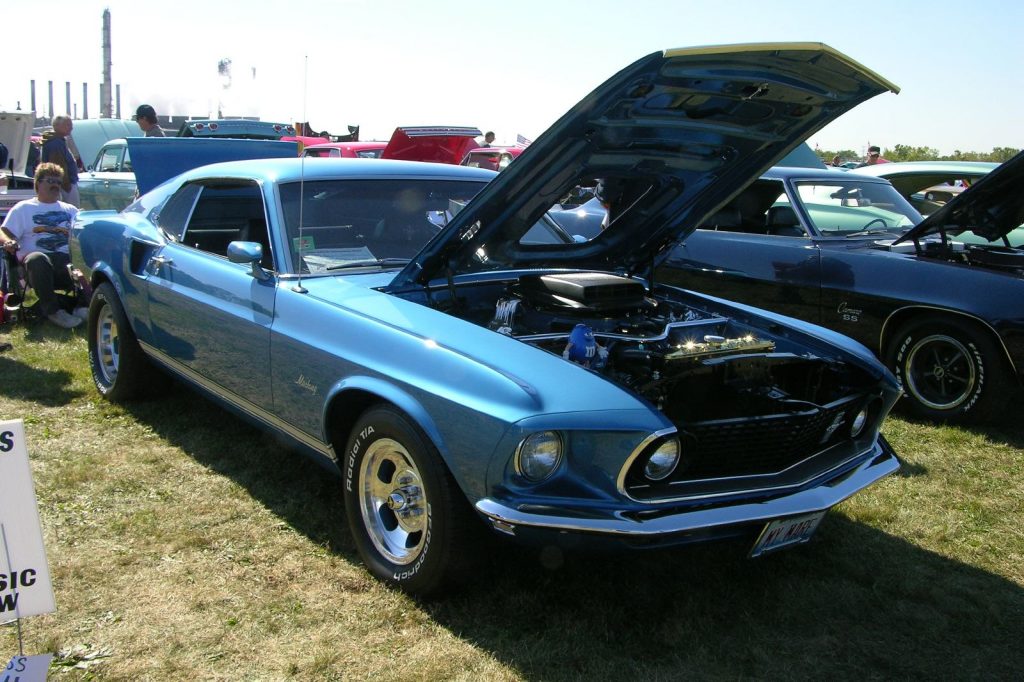[lwptoc skipHeadingLevel=”h1,h4,h5,h6″]
Lee Iacocca, the general manager and vice president of Ford in the 1960s, envisioned a sporty automobile marketed on the youth and based on the compact Falcon. Developed on a shoestring budget and in record time, Ford proudly made the first classic Mustang available in dealerships on April 1964.
This automobile was destined to become a much-loved and classic American muscle car. Almost half a million Mustangs were rolling down the freeways just within a year of its introduction. The success of the Mustang launch eventually resulted in multiple competitors from other American car manufacturers, including the Pontiac Firebird and the Dodge Charger.
This Classic Car Spotlight will zero in on a particular model of the first-generation Mustang: the Ford 1969 Mustang.
1969 Mustang Specifications: An Overview

Ford decided to completely revamp the design of the Mustang in the 1969 model to make it look different from the previous years. When the manufacture restyled the 1969 Ford Mustang, they made this model longer and heavier) than its predecessors.
Ford also did away with the 2+2 Fastback moniker and replaced it with the SportsRoof brand. The car manufacturer wanted to differentiate SportsRoof Mustang from the rest by giving it a unique code number and a different body style.
Interior and Exterior Colors
The 1969 Ford Mustang came with 17 exterior colors. Car buyers looking to get this model can special order several colors on any convertible, fastback or hardtop.
On top of these 17 colors, the car company introduced several color specials in 1968. The Rainbow of Colors initiative, a West Coast-focused promotion, enabled new Mustang owners to order an auto in one of 13 factory colors.
Some of the color options offered to car buyers were the following:
- Madagascar Orange
- Moss Green
- Sierra Blue
- Whipped Cream
- Forest Green
- Spanish Gold
- Hot Pink
- Dandelion Yellow
A Look at the 1969 Ford Mustang Engine
The base engine for the 1969 Mustang model continued to be the 200-cubic-inch six-cylinder. The car, however, did come with an optional 250-cubic-inch six-cylinder for the economy-minded Mustang motorist.
Other than the existing base V8, other engines entered the lineup. These were the 4V V8 engine and the 351-2V engine.
Ford also offered two special engines for the classic 1969 model: the Boss 429 and the Boss 302. These, however, were available only for two production units.
New Features that Came with the 1969 Mustang Model
The engines aren’t the only noteworthy aspect for the 1969 Mustang. This model also came with the following new features:
- A choice of automatic transmission or a 4-speed manual transmission
- Quad headlights
- Front disc and power brakes
- Front parking lights, which the driver can find behind the front valence panel
- The vehicle identification number (VIN) attached to the driver’s front door and the instrument panel
- White sidewall tires
- Front seatback locks
- (On SportsRoof models) Integral rear spoiler, side scoops and quarter panel ornaments
Ford 1969 Mustang Special Edition Models and Variants

The car manufacturer offered several new models for the 1969 Mustang. Auto buyers can choose from one of these variants:
The Going Thing
Ford was involved in the ’60s, and “The Going Thing” was one of the advertising themes of the auto manufacturer. The company’s Cleveland sales district was the one behind this regional special promotion edition.
What made this model unique was that 109 Mustangs featured special stripes with the text “The Going Thing” written on the rocker. These vehicles also came with all sorts of engine sizes.
Ford T-5
This 1969 Mustang model lacked the wow factor from a customization perspective. It does, however, have a cool backstory.
Sometime in the 1950s, Krupp (a German truck manufacturer) introduced a general-purpose truck and called it the “Mustang.” The manufacturer held copyrights to the Mustang name and continued to produce this vehicle for many years. This situation was a problem for Ford when they were attempting to sell its 1969 Mustang model in Germany.
Instead of purchasing the Mustang name from Krupp, Ford decided to modify the name of its exported Mustangs to Ford T-5s. The T-5 didn’t carry a specific meaning. It just served as the original project name for the Ford Mustang.
4.1 Liter Special
There’s not much information about this particular model apart from the fact that it was a promotion for the Indianapolis area. The vehicles came with a 4.1-liter special checkered flag fender badge, a white and gold pinstripe and an automatic L-code 4.1-liter six-cylinder engine.
Limited Edition 600
Ford’s sales district in Philadelphia made the Limited Edition 600 as a promotion. Custom colors were available in Groovy Green and Flower Power Red.
Mustang E
Ford offered this 1969 Mustang model to people searching for a more fuel-efficient car. Although the Mustang E wasn’t a fast car, it carried a high miles per gallon (MPG) that trumped other gas-guzzling models.
Mustang GT Package
This 1969 Mustang model was available as a SportsRoof, hardtop or convertible model. It came with various features, including a stiffer suspension, a GT gas cap, and a 351 two-barrel engine.
The Shelbys
What’s unique about this model is that it shared little resemblance to the production Mustang. Ford based the Shelby variants on the convertible and SportsRoof body styles.
Mustang Mach 1
The 1969 Mustang Mach 1 featured a hood scoop, a matte black hood and NASCAR-style hood lock pins. It also included a handling suspension along with an extra 55 pounds of insulation and sound deadener materials.
Mustang Boss 302 and Boss 429
Ford wanted to call this model “Trans Am.” Unfortunately, General Motors had already licensed that name. Ford then settled with “The Boss” name and introduced two variants: the 302 and 429.
The Boss 302 had a 290 gross horsepower rating. The actual horsepower, however, was more like 350.
Ford also produced the Boss 429 as a response to Chrysler’s major success with the 426 Hemi in NASCAR. This particular variant came with a Semi-Hemi 429 powerplant.
Mustang Grande
This fancy hardtop Mustang comes with a deluxe interior and a special trim similar to Mach 1. Paying extra allows car buyers to enjoy other cool features, including luxury foam bucket seats, color-keyed racing mirrors and an upgraded two-spoke steering wheel.
How Much is a Classic 1969 Mustang?

The valuation tool from Hagerty revealed that the current values for the 1969 Ford Mustang are as follows:
- Concours (the best out there) – $22,900
- Excellent – $16,200
- Good – $9,900
- Fair – $5,600
As you can see, the 1969 Mustangs for sale are affordable. The Mustangs made by Ford are ideal for people who want a stylish car at blue-collar prices.
This still holds true today. An article from MotorBiscuit revealed that the base price of the modern 2020 Ford Mustang is $27,765.
Although the prices of cars are rapidly rising in the United States, this does not necessarily mean you can no longer obtain fantastic deals on powerful and fun vehicles. You’re bound to stumble upon a good offer for a classic or modern car if you look hard enough.
What to Check Before Purchasing a Classic Mustang

When you’re buying a 1969 Ford Mustang (or any classic Mustang that you fancy), don’t just look at affordability. You need to make sure that the car you’re going to buy is still in decent condition.
During your vehicle inspection, examine the following:
Electrical System
A faulty electrical system can prevent important car components, such as the signals and headlights, from working properly. Make sure you check this system for problems.
Shock Towers
You’ll want to drive a 1969 Mustang with good structural integrity. Take a pass on vehicles with shock towers presenting cracks or metal fatigue.
Rust Damage
No matter how “vintage” your automobile is, you should never throw away your money on a rust bucket. When checking out a classic Mustang, inspect for signs of heavy rusting. Also, avoid getting cars with rust holes. A few common areas you should check include the wheel wells, the trunk, the floorboards beneath the carpet and the cowl area under the dash.
The 1969 Ford Mustang is one of the classic pony cars that you could consider owning. On top of its sleek styling, it’s easier to fix and maintain thanks to its massive aftermarket. If you’re a first-time vintage car buyer, you’ll want to start your purchase with a Mustang.





